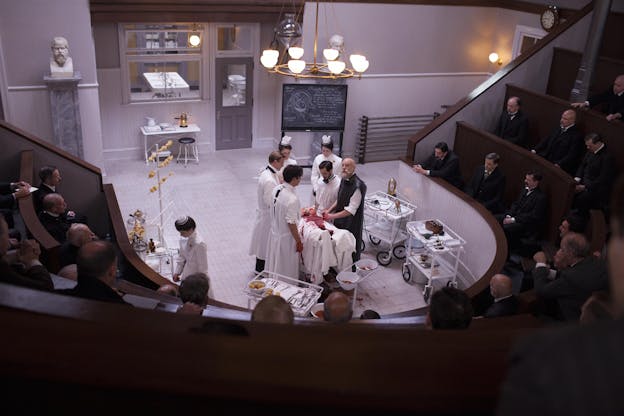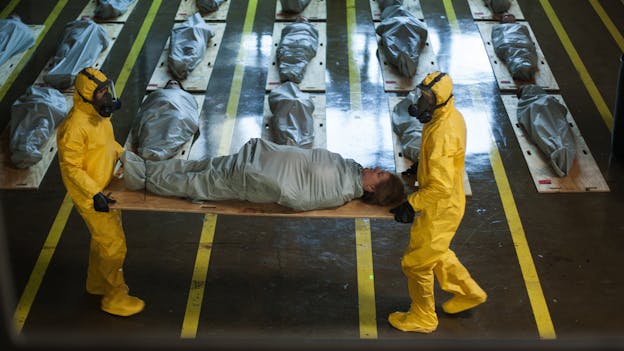In the early aughts, watching television became a feat of endurance. In long-running drama shows like The Sopranos and Breaking Bad, we rationalized the deeds of charismatic anti-heroes, binging on behavior we’d otherwise find reprehensible. And in comedy, we found the Cringe. Shows like The Office, Parks and Recreation, Curb Your Enthusiasm, and Louie taught us to revel in social awkwardness. Just try to make it through David Brent’s interminable dance number on The Office; wrestle with a mix of empathy and revulsion as you realize it’s possible you might agree with Larry David’s social ethics; dare yourself to think that Louis C.K. is a “good guy” after he stalks, assaults, and inadvertently belittles the women of his dreams. We cover our faces, we tense our muscles. This is the trick of cringe comedy: it makes the social feel tangible.
But what about when the discomfort onscreen is already physical? The opening sequence of the first season of The Knick, a series about the birth of modern surgery at the turn of the twentieth century,features an excruciatingly long, lingering depiction of a failed placenta praevia surgery. Steven Soderbergh paints the scene—and all of The Knick’s scenes—with gloriously unnerving High-Definition digital grain. The anachronism of a (noticeably) digital image representing a medical culture at the mercy of insufficient technology is just enough to make the viewer self-conscious but not enough to pull them out of the immersive action. The gore here is the point; the splatter and ooze aren’t augmenting the dramatic action, they are the dramatic action.
The Knick, like HBO’s The Leftovers, also returning this month, is post-cringe. Even Lena Dunham’s Girls, which began as a millennial take on the cringe model, has edged its own boundaries in this way, introducing real violence and pain to mirror the social violence of Hannah Horvath’s world. (In the latest season, for instance, we witness Cleo, played by poor innocent Maude Apatow, getting her frenulum—the skin under your tongue—pierced in excruciating close-up.) Let it be said that these are not particularly popular shows. Both The Leftovers and The Knick were renewed for second seasons despite relatively tiny viewerships, and Girls survives abysmal ratings—the frenulum episode of Girls was considered a relative success with just over 700,000 same-day viewers—by force of personality alone. And that’s what makes their hostility so fascinating. These series are niche entertainment in almost the exact same way that BDSM is a niche kink. Not everybody likes this patter, but it gets somebody off.

In some ways, these shows might not seem substantially different from the “torture porn” of Eli Roth, the New French Extremity horror movement, or the works of Michel Haneke and Lars Von Trier. Moira Weigel usefully grouped the latter of these films together as what she calls “sadomodernism,” a quasi-movement that believes “the only honest and decent thing for art to do is inflict pain.” And these films are themselves indebted to earlier cinematic provocateurs like Luis Bunuel and Pier Paolo Pasolini, who similarly used the shock of unblinking violence to stun their viewers into thought. The most generous way of looking at these films is that they are reactions to the casualization of violence, the desensitization of culture. They hold the viewer responsible. The ungenerous way of looking at these films is that they are bullying, didactic, or exploitative.
The major difference between post-cringe series and their violent, cinematic predecessors is time. While a Lars Von Trier movie may take only a few hours, television unfolds through a serialized narrative, allowing a show to prolong an ordeal, play variations on it, and even occasionally relieve us from it. TV can make us feel worse for longer. In the case of The Knick, the horror is unrelenting, but cleverly so. We are not constantly exposed to gruesome surgeries. Racial tensions flare when an African American doctor is hired at the hospital; a nun is forced to work outside the system to provide safe access to abortions; a woman is exposed to the sexist quackery of early twentieth-century psychiatric care—the bulk of the series deals with the way that this messy period of medical progress reflects the messiness of social life. And, to represent that visually, we see everything from brothels to stately parlors with the same lens that shows us spinal taps and infected guts.
The Leftovers debuted last year playing a slightly different game. A series about the grief-stricken aftermath of a “Rapture”-like event called the Sudden Departure, it’s pretty hard to watch. The protagonist shoots a dog in the pilot, a teenage girl is locked in a rusted out refrigerator, and a mid-season episode began with the close-up stoning of an elderly woman. After that episode a number of prominent TV critics publicly “quit” the show in frustration and disgust. But it wasn’t just the violence. Viewers complained that the show was too “bleak,” that none of this pain seemed to be going anywhere. As I argued at the time, this seemed like a natural reaction to a show more invested in atmosphere and aftermath than a propulsive plot. The problem was not necessarily that The Leftovers was too violent or painful; the problem was that audiences have come to expect that violence and pain make way for narrative satisfaction.
Fairly or unfairly, Damon Lindelof, the co-creator of The Leftovers, has become his generation’s poster boy for audience disappointment. Lindelof created Lost with Carlton Cuse, which begat a frenzied mob of let-down fans after its notoriously unsatisfying finale. He co-wrote the Alien prequel Prometheus which again confused and alienated a devoted fanbase. And he drew the ire of generations of grimacing Trekkies after hornswaggling audiences with the Khan-Not-Khan bait-and-switch of Star Trek Into Darkness, which he wrote for J.J. Abrams. A brilliant screenwriter and an occasionally visionary world-builder, Lindelof has been entrusted with many of the greatest pop cultural mythologies of our time, only to be repeatedly accused of not delivering, not paying off, not making with the rock or the revelation.
The Leftovers, on which Lindelof shares writing duties with Tom Perrotta, has received this criticism maybe most of all. The combination of shocking violence and a mysterious premise led viewers to suspect that there might be some sort of relationship between the two: I endure the violence in order to be rewarded by the opening of the mystery box. But this has always been a fundamental misreading of the series. Lindelof and Perrotta never intended to solve the central mystery—what the hell happened to these people?—they never promised that satisfaction. What was so frustrating and, I think, so genuinely great about the first season of The Leftovers was that it asked viewers to inhabit the cringe for its own sake. There’s a kind of perverse humanity in asking viewers to buy into a fictional world that can feel as purposeless and devoid of answers as their own.
This, obviously, didn’t go over well. With the exception of a few critics—including myself and including Alan Sepinwall, who named it his series of the year—many felt it wasn’t worth the trouble. HBO seemed to agree, but, rather than canceling, the network announced both that the show was to be renewed and that it would be shaking things up, shedding much of the cast, and moving locations. What would The Leftovers look like without all that was cringeworthy and frustrating about it?

I’m happy to report that the new Leftovers is almost exactly as cringeworthy and frustrating as it was before. In fact, rather than dial back the pain or dial up the exposition, The Leftovers has managed to become considerably more painful and more mysterious while also addressing the fundamental complaint viewers had with the first season. In other words, rather than solving the central mystery of the Sudden Departure or producing a kinder, fuzzier version of itself, The Leftovers has added a new, but eminently solvable, mystery. The Leftovers has become more audience-friendly by becoming slightly harder to watch. As they say, there’s no way out but through.
The first episodes of this new season are narratively jarring (the season opener begins in what seems to be pre-historic times, and we don’t see a recognizable face until almost halfway through the episode), they’re shot through with disturbing and surreal images of violence, but, more than that, they play with our anticipation of cringeworthy shocks. A suspicious pie gets passed around multiple kitchen counters like Chekhov’s gun, a man spends an almost unbearable amount of time with his hand down a garbage disposal, our protagonist spends an even longer time with his face pressed up to a malfunctioning gas burner waiting for his cigarette to light or his face to burn off—so far, none of these moments deliver the bloody coup de grace, but we dwell in expectation of it. Traumatized by the first season, we shudder at every perceived threat, real or imaginary.
This new season may not catch on. The Leftovers is an opera of disappointment. It’s also phenomenally gripping television. And then there’s the mystery. If the first season of The Leftovers dropped us into a topsy-turvy world that we couldn’t solve, the second season gives us Jarden, TX, a place untouched by the Sudden Departure but hiding a secret that looks to be much more sinister. The show is not backing off from the fundamental inexplicability of its world—its central frustration—or its post-cringe aesthetic, but it seems newly willing to fabricate a mystery to solve. We’re not going to find out where everybody went, but we might well begin to realize where those of us leftover are now.
